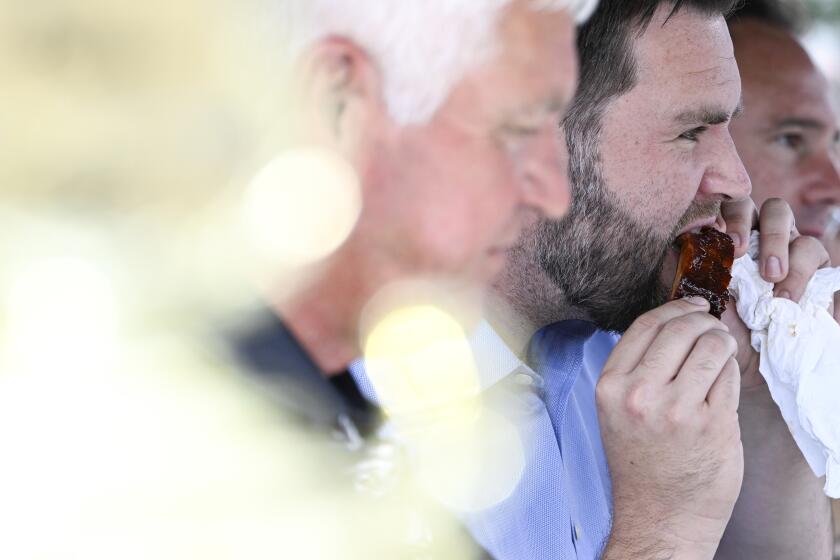State Lends a Strong Hand to Crime-Fighting With DNA
For years, criminal investigators have seen it shimmering on the horizon: a new era in their grim work when they would spend less time searching for a suspect and more time tying the suspect to a crime.
DNA fingerprinting, they have argued, would fundamentally shift the odds in detective work, away from even the most cunning criminals and toward the police.
But DNA as a crime-fighting tool has not yet lived up to those expectations in the United States. Now police officials believe that could start to change as California begins to implement the newly passed Proposition 69.
The most populous state, now with the most aggressive DNA law in the nation, may help propel DNA use nationwide -- a prospect that cheers many police officials as much as it troubles some civil libertarians.
“California will very quickly become the ‘hit’ leader in the nation,” said Paul Ferrara, the head of Virginia’s highly regarded Division of Forensic Science, employing the term used when a DNA sample from a crime scene shares genetic markers with that of a person. “And they’ll get a lot of ‘hits’ for crimes in other states and criminals in other states.”
Proposition 69, approved by voters 62% to 38%, immediately mandates that a DNA “fingerprint” be taken from all adults and juveniles convicted of a felony, as well as all adults arrested for murder or certain sex offenses -- whether or not they are convicted. In 2009, the law expands to include any person arrested for a felony or for some misdemeanors, also regardless of a conviction.
The FBI’s national databank, the Combined DNA Index System, or CODIS, now contains about 1.5 million names. If California is able to keep up with its new law, the state could add 1 million new names in a few years.
The law’s provision to take DNA from people who are arrested but not convicted has particularly disturbed civil liberties advocates. Proposition 69 provides a way for people who are exonerated to have their DNA removed from the database, but critics say the method is cumbersome.
The American Civil Liberties Union is considering going to court to try to block the law, although legal challenges to DNA databases in other states have so far been generally unsuccessful.
By contrast, the logistical challenges of testing and recording tens of thousands of DNA samples may be more formidable, requiring considerable money and manpower. Although the law will not reach its full scope until 2009, the expansion of the database will begin immediately.
The first effect of the new law is expected to be felt in the state’s massive prison system. There are more than 165,000 inmates in California prisons, the majority of whom have not been required to give a DNA sample under the state’s existing law, which covers only those convicted of crimes defined as serious felonies. Under Proposition 69, all inmates will be required to give samples.
Tens of thousands of inmates are paroled annually, according to the California Department of Corrections, and thousands leave city and county lockups each day. They are at the top of law enforcement’s list to sample.
“The focus right now is who’s in jail, and who’s in prison,” said David LaBahn, executive director of the California District Attorneys Assn. “If somebody’s going to get released today, let’s get their DNA first.”
Between inmates, parolees and new felony convicts, the state could in one year roughly double the 250,000 DNA “fingerprints” now in its database.
Testing will be done with Q-tip-like devices that take a sample from the lining of the inner cheek. Lance Gima, head of California’s Bureau of Forensic Services, which is responsible for the state’s databank, estimated the cost per test at between $50 and $60.
The first batch of swabs for Los Angeles County is expected to arrive this week, and officials from the state lab are planning to begin training before the end of the month.
Until recently, the Los Angeles Police Department was gathering so much more DNA evidence than it could process that it was buying a new refrigerated trailer every few months to store untested samples.
It wasn’t alone. In 2001, New York City still had 16,000 rape kits that were untested.
Thanks primarily to federal grants, most of the backlog at the LAPD -- and in many other California jurisdictions, as well as New York and other places -- has now been processed, officials say. Gima and other officials say they think that the state will be able to handle the rapid scaling up of the database.
But the existing statewide databank is still relatively undeveloped, even as it is about to be inundated with new samples. In October, the state received an additional $9.9 million in federal money to further develop the database.
The state legislative analyst expects Proposition 69’s mandate to cost nearly $20 million a year once it is fully in place. The program is to be funded primarily by raising fines for some offenses by $1 for every $10 currently levied.
In the first years, most of the money will go to the state to assemble the database. If all goes smoothly, after five years, the bulk of the money will shift back to local jurisdictions to pay for the cost of running samples through the computers.
Because some arrestees will be sampled beginning immediately, and many more in five years, every jail and booking station in the state will have to determine who must be sampled and who already has been sampled -- a task likely to be difficult because of the confusing welter of people in local jails.
In Virginia, which began the nation’s first large-scale DNA database in 1989, nearly one-third of the people tested in the early stages of the database already had been sampled -- a costly and time-consuming error, Ferrara said.
Getting the DNA from suspects into the computers is only half of the equation. DNA databanks are, in fact, two different banks of information -- one containing the genetic identification of known individuals, the other of evidence from crime scenes. The data from one side is compared with that of the other in the quest for a “hit.”
When two DNA samples share the same markers, there is a strong likelihood that the samples came from the same person. The larger the number of markers, the stronger the odds that the source is the same, although scientists -- and defense lawyers -- are quick to note that there is no such thing as a 100% match.
Once the database is up, the process of searching for a hit should take police a matter of days, officials say. The computer search through the database is relatively quick, they say.
Many civil libertarians see the coming large-scale expansion of the DNA database as a threat. “I think there are potentially major issues about genetic privacy,” said British scientist Alec Jeffreys, the man whose scientific discoveries 20 years ago inadvertently opened the way for genetic-based crime fighting. Jeffreys made his remarks to reporters recently in England.
Law enforcement officials insist those fears are overblown. DNA databanks contain limited genetic identifiers, not thorough studies of a person’s entire genetic code, they point out. And, they said, they already routinely collect fingerprints and other identifying information from people who are arrested.
On the other side of the balance, they say, the databanks have repeatedly proved their worth.
Virginia, home to 7 million people, recorded its 2,000th hit in June, some 220 of those for murder cases, 420 for sexual assaults, and 1,180 for property crimes.
California, with 36 million people, has recorded about 1,100 hits in 10 years with its more limited database.
Virginia authorities estimate that more than 80% of hits in the state would never have been made had its databank been limited to samples from violent offenders. About one-third of the violent crimes the Virginia authorities have solved through the databank lead to people whose DNA was in the system for previous nonviolent offenses.
In Wisconsin, which has a six-year statute of limitation for rape, Milwaukee prosecutors have sought to resurrect cases about to expire by filing “John Doe” arrest warrants based on the genetic markers of the rapist, even though the identities are unknown.
Out of eight such cases filed since 2000, prosecutors have garnered six convictions, said Milwaukee County Assistant Dist. Atty. Norman Gahn.
And in Britain, where anyone arrested for a crime is subject to DNA identification, about 3,000 hits per month are registered, a spokesman for the government’s Home Office said. Britain has roughly 60 million residents.
It is experiences like those that make authorities in California and across the country see promise in the new law.
“There are going to be a few growing pains, sure,” said Virginia’s Ferrara. “But once those things get ironed out, this thing is going to become a boon to public safety. When you get that critical mass of convicted felons or arrestees in a database, and a lot of crime scene evidence, and you start matching them up ... you’ll be solving two, three, four crimes at a time.”
More to Read
Get the L.A. Times Politics newsletter
Deeply reported insights into legislation, politics and policy from Sacramento, Washington and beyond. In your inbox three times per week.
You may occasionally receive promotional content from the Los Angeles Times.










